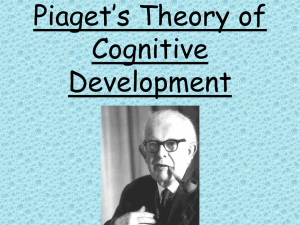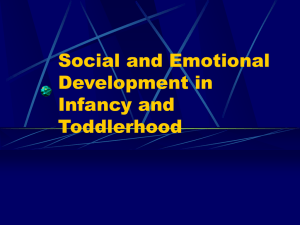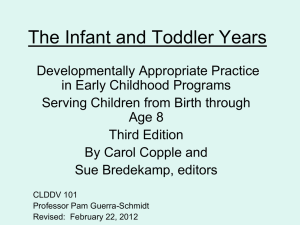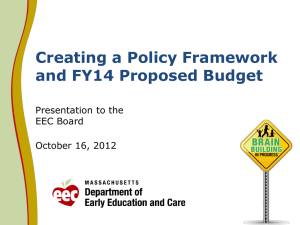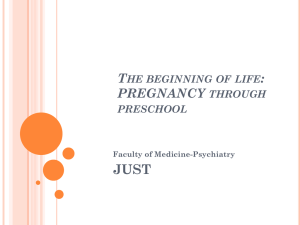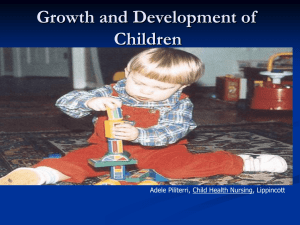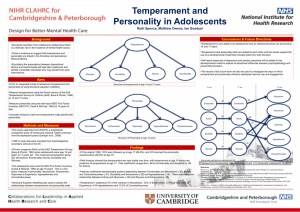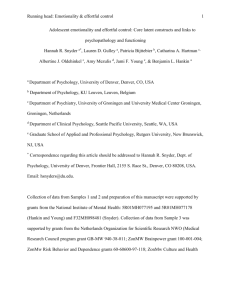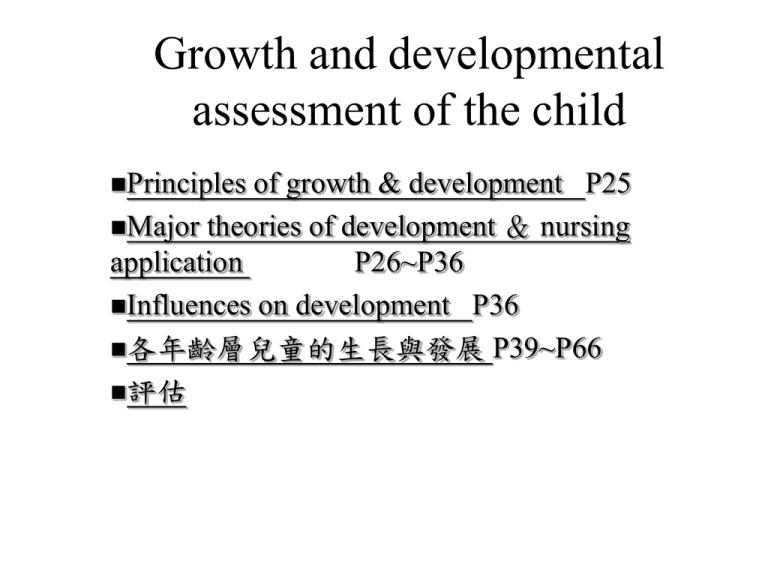
Growth and developmental
assessment of the child
Principles
of growth & development P25
Major theories of development & nursing
application
P26~P36
Influences on development P36
各年齡層兒童的生長與發展 P39~P66
評估
Principles of growth & development
P25
The exact age at which skill emerge differs, but
the sequence or order of skill performance is
uniform among children. 第2段第2行
Cephalocaudal development
Proximodistal development
Physical size, motor skills, cognitive ability,
language, sensory ability, and psychosocial
patterns.
These assessments can guide the nurse in
planning interventionsfor the child and family.
Major theories of development & nursing application
P26~P36
Simon Freud-psychosexual
Erik Erikson-psychosocial
Jean Piaget-cognitive development
Chess & Thomas - Temperament theory
心理社會發展
Simon Freud
Psychosexual
id 、ego (defense mechanism P27)、superego
oral、anal、phallic、latency、genital P27
心理社會發展
P27, 29, 30
Erik Erikson
Psychosocial
Trust v.s. mistrust (birth to 1 year)
Autonomy v.s. shame and doubt (|1 to 3 years)
Initiative v.s. guilt (3 to 6 years)
Industry v.s. inferiority (6 to 12 years)
Identity v.s. role confusion (12 to 18 years)
Two possible outcomes
P27倒數第四行最後
• Healthy& moves on to future stages
• Unhealthy outcome & will influence future
social relationships.
Jean Piaget
P30~32
Cognitive development
Accommodation(適應)
Assimilation(同化)&change
Sensorimotor (birth to 2 years)
Preoperational (2 to 7 year)
Concrete operation (7 to 11 years)
Formal operation (11 years to adulthood)
Chess & Thomas
P34~36
Temperament theory
先天就決定的對內在或外在刺激的反應模式
Nine parameters of response to daily events
(Table 2-5)
P35
Three major personality types (Table 2-6)
Nursing Application
P35
Influences on development
P36
Genetics
Prenatal influences
Cultural influences
Others influences
Nutrition、Family structure、School、
Stress、Socioeconomic influences、
Community、Media
各年齡層兒童的生長與發展
Physical growth and development
Cognitive development
Injury prevention
Personality and Temperament
Play and communication
Sexuality
P39
Infant
Physical growth and development
P40-42
The first year of life is one of rapid change for the infant. P40第1段
The birth weight usually doubles by about 5 months and triples by
the end of the first year(Figure 2-7*).
Height increases by approximately l foot during this year.
Teeth begin to erupt at about 6 months, and by the end of the first
year the infant has six to eight deciduous teeth (see Chapter 4).
Kidney and liver maturation helps infant excrete drugs or other
toxic substances. P40第2段
Maturation of the nervous system is demonstrated by increased
control over body movements, enabling the infant to sit, stand, and
walk.
Sensory function also increases as the infant begins to discriminate
visual images, sounds, and tastes.
參考Table 2-11
Infant
Cognitive development
The newborn's eyes widen an response to sound.
Turns to the sound and recognizes its significance.
The 2-month-old cries and coos
1/y says few words and understands many more.
The 6-week-old grasps a rattle .
The l-year-old reaches for toys and self-feeds.
The infant receives stimulation through sight, sound, and
feeling, which the maturing brain interprets. This input
from the environment interacts with internal cognitive
abilities to enhance cognitive functioning.
P42-43
Infant
Injury prevention
P44
Major cause of death in childhood.
Increasing mobility
Infant
Personality and Temperament
P45
They may display varying degrees of regularity in
activities of eating and sleeping, and manifest a capacity
for concentrating on tasks for different amounts of time .
The parents can appreciate more fully the uniqueness of
their infant and design experiences to meet the infant's
needs. Parents can learn to modify the environment to
promote adaptation.
Although the infant's temperament is unchanged, the
ability to fit with the environment is enhanced.
Toddler
First adolescence.
Displaying independence and negativism .
Physical growth and development
P47
Growth slows
By age 2 years, the birth weight has usually quadrupled and
the child is about one half of the adult height.
Body proportions begin to change, with legs longer and
head smaller in proportion to body size than during infancy
(see Figure 2-7).
The toddler has a pot-bellied appearance and stands with
feet apart to provide a wide base of support.
By approximately 33 months, eruption of deciduous teeth is
complete, with 20 teeth present.
粗及精細動作發展圖P48, P49Table 2-16 Toilet Training
Toddler
P47
Cognitive development
Preoperational stage
Object permanence is well developed.
About 2 years of age, increasing use of words .
Rudimentary problem solving, creative thought,
and an understanding of cause-and-effect
relationships are now possible.
Toddler
Injury prevention
P49
Family want to know
P50
Table 2-18 Injury Prevention in Toddlerhood P51
乘坐對象
乘
坐
標
準
安
全
椅
放 置 位 置
使用安全椅
種 類
一
一歲以下或 體重未到
達 10 公斤嬰兒
二
一至四歲以下或體重
汽 車 後 座 兒童用座椅
在 10-18 公斤幼童
三
嬰兒用安全
汽 車 後 座
椅或臥床
四歲至十二歲以下 或
體重在 18-36 公斤 汽 車 後 座 使用安全帶
兒童
每個安全椅以乘坐一位兒童為限,以維護兒童乘車安全。
九十三年六月一日起,兒童未依規定乘坐安全椅,處駕駛人
新臺幣五百元罰鍰。
Toddler
Personality and Temperament
P50
The toddler retains most of the temperamental
characteristics identified during infancy, but may
demonstrate some changes.
Increasing independence characteristic of this
age is shown by the toddler's use of the word no.
Preschool child
P52
A time of new initiative and independence.
Most children are in a child care center or
school for part of the day and learn a great deal
from this social contact.
Language skills are well developed, and the
child is able to understand and speak clearly.
The world of busy preschoolers.
Preschool child
Physical growth and development
P52-54
Grow slowly and steadily, with most growth
taking place in long bones of the arms and legs..
Runs with ease, holds a bat, and throws balls of
various types.
Writing ability increases, enjoys drawing and
learning to write a few letters.
Begin to brush their own teeth, and schedule the
first dental visit so the child can become
accustomed to the routine of periodic dental care.
Table 2-20.
P54
Preschool child
Cognitive development
Preoperational thought.
Symbols or words
Still has some limitations in thought (Table 2-22).
Preschool child
Injury
prevention
P55
Increasing independence.
At high risk of injury from fire, drowning,
and motor vehicle and pedestrian accidents.
Preschool child
Personality and Temperament
P55
Characteristics of personality tend to persist over
time.
The preschooler may need assistance as these
characteristics are expressed in the new situations
of preschool or nursery school
To identify the child's personality or temperament
characteristics and to find the best environment for
growth..
School-age child
Physical growth and development
Long bones continue to grow, leg length increases.
Fat gives way to muscle, and the child appears leaner.
tooth
P58
the first deciduous tooth is lost at 6 years and permanent teeth begin
to erupt.
Closely monitored to ensure that brushing and flossing are adequate.
Loose teeth are identified before surgery or other events that may
lead to loss of a tooth.
Body organs and the immune system mature.
Medications are less likely to cause serious side effects.
The urinary system can adjust to changes in fluid status.
Rapid increases in size commonly occur during school age.
Physical skills are also refined . (Table 2-25).
School-age child
Cognitive development
P59
Concrete operational thought at about 7 years.
Consider alternative solutions and solve problems.
Rely on concrete experiences and materials to form
their thought content.
Learns the concept of conservation.
School-age child
Injury prevention
P61
Play in unsupervised settings for longer periods
.
School-age child
Personality
and Temperament
P62
The enduring aspects of temperament
continue to be manifested during the
school years.
Creative efforts and alternative methods of
learning should be valued.
Encourage parents to see their children as
individuals who may not all learn in the
same way.
School-age child
Sexuality
P62
Although children become aware of
sexual differences between genders during
preschool years, they deal much more
consciously with sexuality during school
age.
Need information about their bodily
changes .
Become interested in sexual issues .
Adolescent child
A period of identity formation.
Physical growth and development
P62
The physical changes ending in puberty, or sexual maturity,
begin near the end of the school-age period.
The prepubescent period : growth spurt.
The increase in height and weight is generally remarkable.
Girls :breast size , pubic hair & menstruation occurs.
Boys: penis and testes size , pubic hair, deepening of the
voice and growth of facial hair occur later.
Take adult doses of medications.
Table 2-28
Adolescent child
Cognitive development
P63
Formal operational thought.
The ability to reason abstractly.
The ability to think and act independently leads
many adolescents to rebel against parental
authority. Through these actions, adolescents
seek to establish their own identity and values.
Adolescent child
Injury prevention
P63-65
They often believe they are immune from harm. This
encourages adolescents to put themselves at high risk
from dangerous behaviors . P63倒數第3行
Motor vehicle crashes, suicides, and homicides cause
75% of adolescent deaths . P63此段第1行
Suicide among adolescents has increased by 300%
over the past four decades and is the second leading
cause of death from l5 to l9 years(MMWR, 1995;
Hayden & Leuer, 2000) . P64第2行
The high rate of stress experienced, harmful
substances and firearms promotes death by suicide.
P64倒數第4行
Violence is an increasingly important factor in
adolescent injury. P65 第2段第1行
Adolescent child
Personality
and Temperament
P65
Characteristics of temperament manifested
during childhood usually remain stable in
the teenage years.
It is also common for an adolescent who
was an easy child to become more difficult
because of the psychologic changes of
adolescence and the need to assert
independence.
Adolescent child
P66
Sexuality
Achieves sexual maturity
Interactions with members of the opposite sex.
The forces of society and family
Identity formation.
評估
兒童完整健康史
身體檢查與評估
身心發展評估工具
兒童完整健康史
個人:病史、營養史、發展史
家庭評估:家族史、家庭內/外在結構、家庭
互動
營養評估:體重及生長發育的情形、血比容
及血紅素、皮膚及皮下脂肪、排泄睡眠精力)
(飲食習慣、進食的量與質、對食物的喜好
以及吸收的狀況
熱量需要量
奶量的計算
副食品添加(嬰幼兒每天飲食建議量)
Physiologic anorexia
熱量需要量
0-6M 115 Cal/Kg
6-12
105 Cal/Kg
<1y/o 110-120 Cal/Kg
1y/o左右 1300 Cal/day
> 1y/o
每增1歲增加100 Cal
奶量的計算
全奶 14%
30 ml = 20Cal
嬰幼兒每天飲食建議量
1~3個月大
牛奶占100%
4~6個月大
牛奶占80~90%
副食品:果汁、青菜湯、麥糊或米糊
7~12 個月大
牛奶占50%~70 %
副食品:稀飯、麵條、蛋
1~2歲
牛奶占30%
身體檢查與評估
技巧--視、聽、叩、觸診
生長測量
身高、體重、頭圍之生長曲線圖、
成長曲線圖
生理測量
體溫、脈搏、呼吸、血壓
器官或系統的檢查與評估
兒童生長可能有問題的情況
身高與體重的百分位相距太大
無法達到預期的生長速度(尤其是嬰幼兒及青
少年期)
成長突然增快或遞減
身心發展評估工具
P197 Table 6-2, P198 Table 6-3
DDST(Denver Developmental Screening Test)
BSID(Bayley Scales of infant Development)
社會適應、精細動作、粗動作、語言發展
心智、動作、行為量表
PDMA(Peabody Developmental Motor Scales
and Activity Cards)
氣質評估量表
活動量、規律性、注意力分散度、趨避性、堅持性、
反映閥、適應性、反應強度以及情緒本質。
氣質量表
嬰兒氣質評估量表
學步期幼兒氣質量表
兒童氣質量表
青少年氣質量表
徐澄清, “小時了了”

